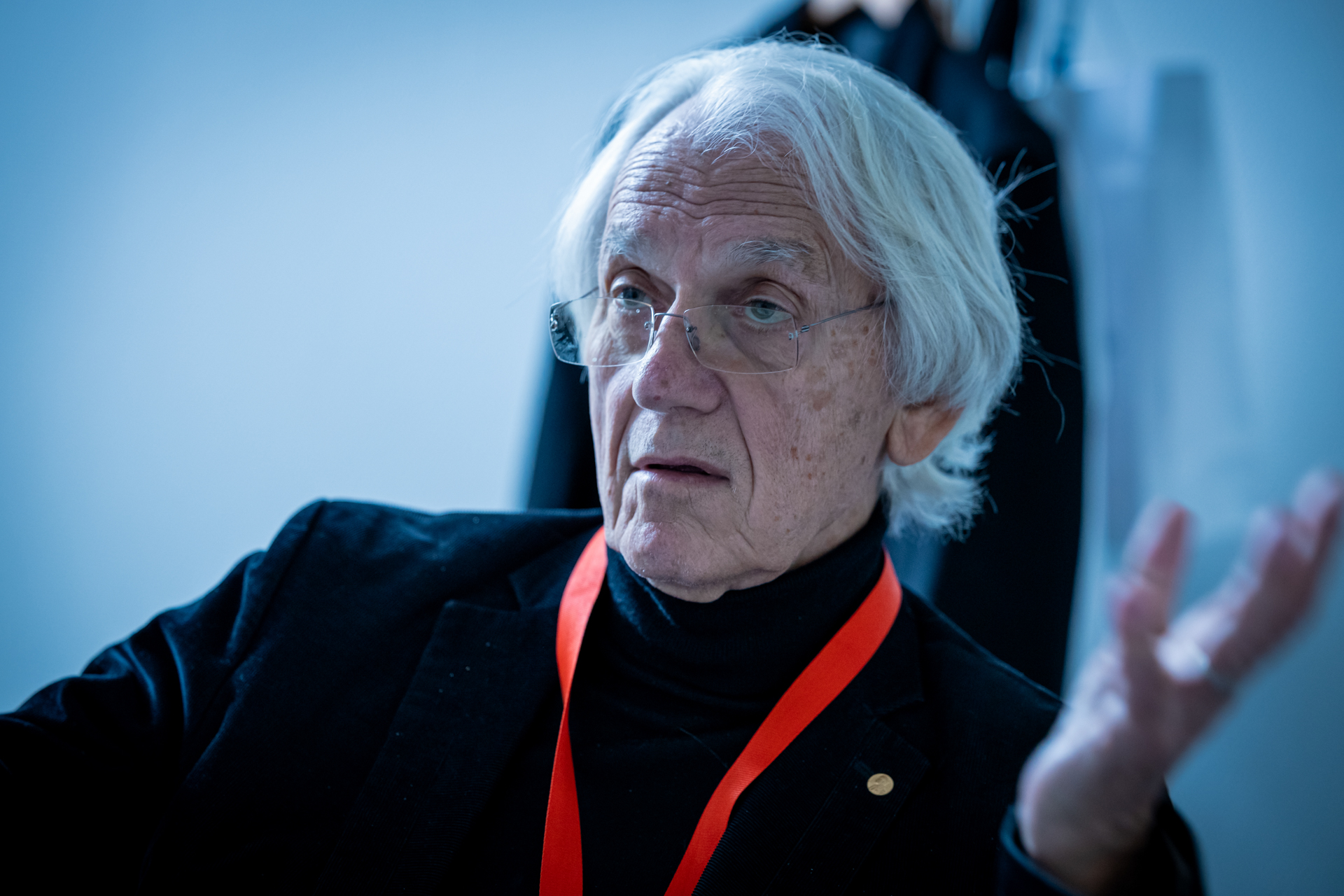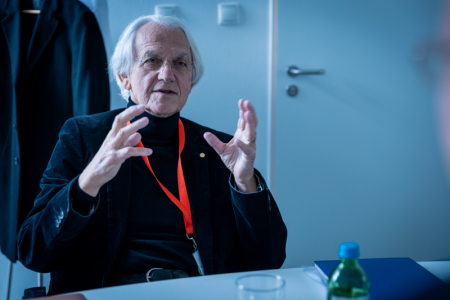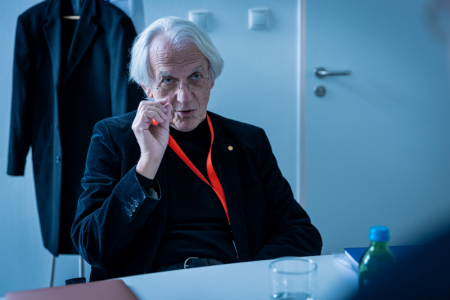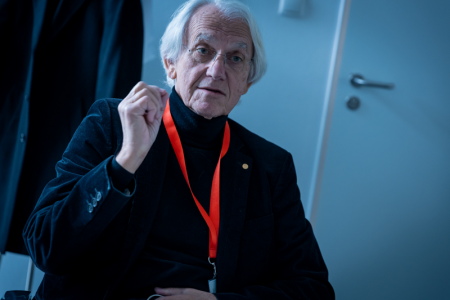
Professor Gérard Mourou, the initiator of the ELI laser infrastructure and the Nobel laureate physicist recognized for his work on chirped pulse amplification technology in 2018, was a guest in Szeged at ELI ALPS. Professor Mourou participated in a seminar held at the research institute on Friday, where Dr. Károly Osvay reported on the results of the first five-year research cycle of the National Laser-Initiated Transmutation Laboratory operating at the University of Szeged. During the event, participants, including former Minister of the Ministry for Innovation and Technology of Hungary - László Palkovics, Minister for Energy - Csaba Lantos, and Gábor Szabó - Managing Director of ELI ALPS, also discussed the prospects for the next period of the laser transmutation project.
- Together with Professor Toshiki Tajima, you proposed the model for a laser-based neutron source that could be used for the transmutation of nuclear waste. Are you satisfied with the results of Károly Osvay's neutron capture experiments generation so far?
- Yes, absolutely, they are progressing in a particularly good direction, and I am happy that I can be involved with it myself. The number of neutrons produced in the experiments conducted so far is promising; no other research group has succeeded in producing such a quantity of neutrons through laser-based methods. Currently, the most important goal is to generate an even larger number of neutrons in an energy-efficient manner.
- What is the ultimate goal of the research, the treatment of nuclear waste, or the development of a clean nuclear energy production process?
- Both. We need to find solutions to the challenges in energy production, so we are looking for an energy source that is clean, cheap, and abundant. I personally believe strongly in the future of nuclear energy, but we must address the safety concerns that arise. It has long been my conviction that ultrashort, ultrahigh-intensity laser pulses offer a solution. During the production of nuclear fission energy, actinide isotopes are inevitably produced that can radiate for hundreds of thousands of years. If we subject them to a transmutation process through neutron irradiation, they break down into elements with shorter radiation time. I mentioned energy production because, for the operation of significantly safer subcritical reactors than the current ones, a neutron source is also required. However, the neutron beam currently requires enormous and expensive linear accelerators and cyclotrons, making it highly costly. Therefore, we have proposed using ultrashort light pulses for their production, and in this regard, the experiments conducted by Károly Osvay's team have made gratifying progress, offering even greater hope for the upcoming experiments.

- Reportedly, during a visit to Szeged in 2018, you convinced the former Minister of the Ministry for Innovation and Technology of Hungary, László Palkovics, to finance the first phase of the transmutation project. In light of the current results, do you recommend funding the second phase of the project?
- Oh, whether I truly convinced him, he would be the one to say. Let's just say that I had a positive impact on the case. The opportunity arose because Hungary already had the world-class laser equipment of ELI ALPS, where the necessary ultrashort laser pulses could be generated, and both the research institute and the University of Szeged had the expertise required for the project. Certainly, I recommend, and based on the results, I now even more strongly advocate for government support for the project. The future energy production is a huge problem for humanity, and this goal aligns perfectly with the joint societal responsibility of science and politics. I sincerely appreciate that Hungarian decision-makers have embraced this project. Soon Janos Csak, the Minister of Culture and Innovation, will accompany me to meet Carlo Rubbia, an Italian physicist and a strong supporter of thorium utilization, who was the former director of CERN and received the Nobel Prize in Physics in 1984 for their decisive contributions to the large project, which led to the discovery of the field particles W and Z, communicators of weak interaction.
- In your Thursday academic lecture, you also mentioned recommending thorium instead of uranium as fissile material. Why specifically this element?
- Firstly, it is significantly more efficient than uranium. I have illustrated that 8 billion kW/h of power can be produced annually by burning 10 loaded trains, or 3 million tonnes of coal, but this process releases 1 cubic kilometre of carbon dioxide into the air. On the other hand, the same amount of energy can be produced by the fission of 300 tons of uranium, while for thorium, only one ton would be needed, and, of course, neither nuclear energy source emits carbon dioxide. Additionally, thorium fission produces much less nuclear waste than uranium, and, not least, it is more abundant worldwide. The production of neutrons is also necessary for the operation of a thorium reactor, aligning with the goals of the project.
- What do you think, how much time will be needed for the first application?
- I believe that after the experiments planned for late autumn this year in the project, we will have a clearer understanding. It will become apparent whether the experimental setup built so far will yield even more neutrons. The use of thorium is being researched by numerous groups worldwide, but the generation of neutrons with femtosecond laser pulses, the focus of Karoly Osvay's research group, is a unique topic globally. It's not the transmutation itself that is the great novelty, but the fact that it is triggered with laser generated neutrons.

- The scientific community recognizes you as a great visionary physicist, and they are not exaggerating, as you were one of the few who proposed the establishment of the ELI infrastructure. Are you satisfied with the results?
- The result is impressive! It is a great experience to be in this beautiful and advanced research environment, especially since similar infrastructures have been built in the Czech Republic and Romania as well. I cannot deny that I am proud of it. Its success is also evident in the fact that Americans would like to have similar facilities, and they come to us in Europe to replicate the ELI model and its equipment. However, I have to be careful about what I say now because there might be someone who will make it happen!
- In your speech at the Academy, you projected the experimental exploration of a completely new realm of physics using high-intensity laser devices. You predict that at intensities on the order of 10^25 – 10^30 W/cm^3, 'ultrarelativistic' optical phenomena can be investigated, leading to the materialization of light. Will this be the experimental science of lasers in the coming decades?
- Yes, it became evident to me once it was clear how high-intensity laser pulses could be generated. Current simulations already suggest that we can go even higher in the intensity range. With ultrahigh-intensity lasers, we will be able to generate even stronger fields, pressure, and temperature, and it is already experimentally apparent that we can obtain a whole range of high-energy radiation and particles through laser methods. There will be no need to build massive accelerator facilities to shed light on unanswered questions in physics. With techniques like laser wakefield particle acceleration studied at ELI ALPS or radiation generation based on surface plasma, several of these questions can now be investigated in the laboratory. I consider the creation of particle pairs in empty space as one of the phenomena that can be studied. Perhaps this will be the ultimate research goal in the field of high-intensity lasers, achievable in the domains of quantum electrodynamics and perhaps quantum chromodynamics.
- Will this assume laser pulses even shorter than attosecond pulses?
- Today's simulations already confirm the feasibility of generating high-energy coherent pulses in the zeptosecond range, specifically in the X-ray domain. This opens the way towards the zettawatt and PeV regimes, ushering in the next chapter of laser-matter interaction.

- When you conceived the CPA laser amplification, for which you and Donna Strickland received the Nobel Prize in 2018, did you ever think that you would be talking about such high intensities?
- No, initially not at all; I was simply curious about the maximum achievable intensity of laser pulses. But later, it became apparent that beyond certain intensities, the strength of the electric field can reach a critical value. I see that from the research of the past decades, two major application areas have emerged: the creation of extremely fast attosecond pulses and, thereby, the observation of extremely rapid atomic and subatomic events. For this achievement, my dear friends Ferenc Krausz and Anne d’Huillier, as well as Pierre Agostini, who is also close to me, received this year's Nobel Prize. The other major application area is the one I proposed myself, namely, achieving extremely high peak intensities with extremely short laser pulses. To achieve high energies, it was not necessary to build massive lasers; it was sufficient to shorten the duration of the pulses. From here, it followed that ultrashort pulses proved suitable for particle acceleration and radiation generation.
- How would you persuade a high school student to pursue a university degree in physics?
- Follow their instincts and curiosity! We all have different personalities, I didn't like receiving advice. I became a physicist because I was curious about phenomena. When the first laser was created on 16 May 1960, I was a high school student. I knew nothing about lasers! But it captivated me because I was interested in how it could be produced. Then, I never regretted it for a moment. There's no recipe for inventing something. The only thing is to remain passionately curious, not to count the years but to patiently continue researching.
Article by Sándor Panek
Translated by D. K.
On the cover: Nobel Prize-winning physicist Gérard Mourou.
Photos by Ádám Kovács-Jerney

